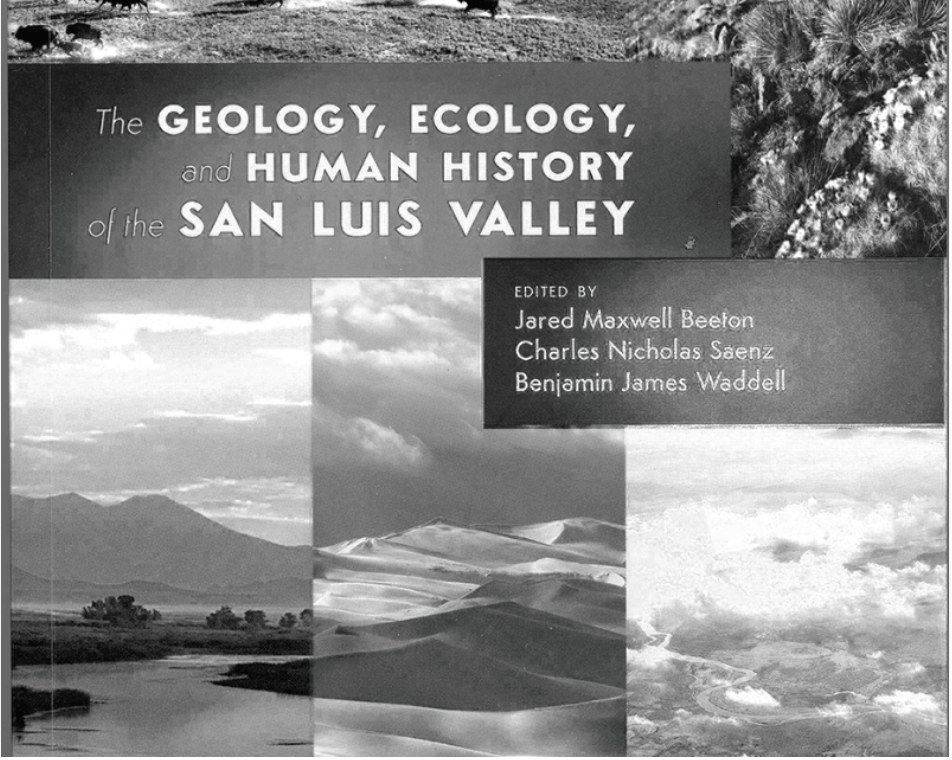
The Geology, Ecology and Human History of the San Luis Valley, edited by Jared Beeton, Charles Saenz and Benjamin Waddell (University Press of Colorado, 2020, paperback at $28.93).
Special places have books written about them. Crestone his its book, Crestone, Gateway to the Higher Realms, by James McCalpin, and we have the Eagle to tell our stories.
Part of our uniqueness is the setting of the town and the Baca on the edge of the spectacular San Luis Valley, or the SLV. This valley is special in many ways. It is the largest high arid valley in the United States. The northern half of the valley is closed, not draining anywhere else. It is surrounded by spectacular mountains, and snow melt provides most of the water which historically made much of the valley a wetland in an arid climate. It has a fascinating history of settlement. We now have a book about the valley, with chapters by experts on the subjects that will help us to appreciate its uniqueness (including our own James McCalpin). Most of the authors are long-time residents of the SLV, as professors at Adam State in Alamosa (and some just outside from Fort Lewis University in Durango) or scientists working in local agencies. All are experts in the fields they write about. The book is organized in three parts, with seven chapters on geology, both basic and applied. There is a good account of our water resources, a chapter on mining, and one on geo-hazards (Jim McCalpin again). There are two chapters on ecology, including one on plants, with an interesting emphasis on ethnobotany, by Kristy Duran (who grew up in Antonito and learned about plant uses from elder women in the community) and another on vertebrate animals by Tim Armstrong (who used to visit the high Sangre de Cristos above Crestone in the winter, tracking predators in the snow).
The second part is on human history in the valley, with six chapters. A chapter on “indigenous lifeways in the valley,” by Mark Mitchell and Angie Krall, traces the long history of human habitation and visitation, over some 12,000 years. This is followed by an accounting of Hispano presence in the valley, going back into the 17th century, and then a detailed analysis of the influences of this settlement on the retention of archaic Spanish language uses in present inhabitants. There are other chapters on the influence of railroads, Japanese immigration, and poverty and discriminatory lending, A final section includes two chapters for the visitor and resident, on fly fishing and rock climbing. Two discussions put all of this in a greater context. First is the foreword by Ken Salazar, the former Secretary of Interior who was raised on a ranch along the Conejos River northeast of Antonito. The second is a discussion of the history of conservation activities in the valley, tracing the development of contemporary organizations, both governmental and NGO, including our own San Luis Ecosystem Council, by Rio de la Vista and Tim Armstrong. Articles are well-illustrated by photographs and maps, and there is a center section of maps and landscapes in color.
Some of the writing is a bit stiff, not surprising given the academic and technical backgrounds of most of the authors. And, a few things are missing, such as the impact of mining districts, particularly Bonanza, other ethnic influxes of settlers, and the rise and fall of valley towns (many small ones, as Moffat, Mosca, and Villa Grove were much larger a century ago). In all, however, this anthology offers a broad and valuable overview of the remarkable valley where we live. At 500 pages of detailed information, the book is a good buy.

